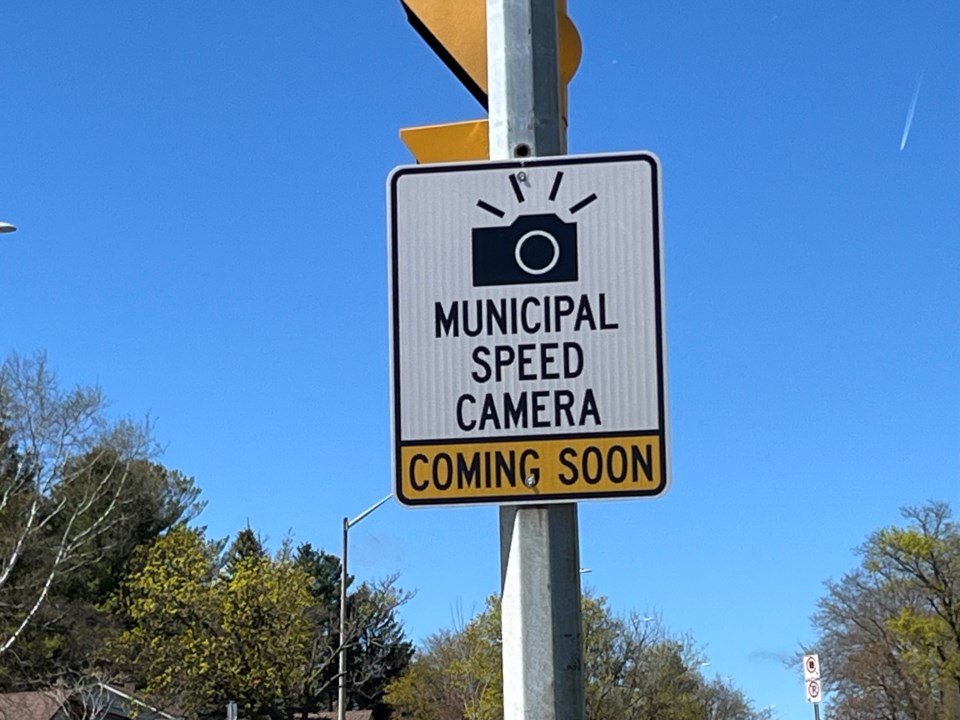Mayor Alex Nuttall wants to ramp up the number of speed cameras on Barrie streets.
Times two, in fact.
His motion that the city lease two more automated speed enforcement (ASE) cameras was approved by community safety committee Wednesday evening.
It could give Barrie four instead of two speed camera zones, since each location requires one camera.
“When I look at the results … we’ve seen a major speed reduction inside the area where we put the cameras,” Nuttall said. “I look at it as a tool to reduce the speed of traffic and then being able to take those dollars and put them into things like raised intersections or intersection pedestrian signals or other safety features that can actually improve safety around our schools, including perhaps a crossing guard program inside of school zones.
“For individuals who are given a fine, these cameras are solely inside community safety zones of schools,” he added. “Those dollars going back into pedestrian safety, going back into community safety, going back into traffic safety, make a lot of sense.”
Nuttall said ASE cameras have proven to be effective in reducing speeds in Barrie’s community safety zones, when used there, and additional cameras would mitigate speeding in additional areas of the city.
ASE cameras in Barrie’s first two locations were successful in significantly reduced speeding there, when compared to the use of flashing 40-km/h lights. During peak school hours speeds were reduced by 12 km/h at the Big Bay Point Road location and 13 km/h at the Anne Street location. This reduction is compared to speeds during peak school hours when the flashing 40-km/h lights were in use.
Councillors also passed a motion Wednesday that city staff prepare a city-wide mailout concerning traffic safety and ASE program, at a cost of $10,000 and to be funded from ASE revenues
“I think this gives (the city) the opportunity to send out something and kind of show all the residents all the different stuff we are doing in regards to safety with our traffic and reinvesting in the safety of our streets,” said Deputy Mayor Robert Thomson.
Barrie’s ASE cameras were first located eastbound on Big Bay Point Road, near Willow Landing and St. Michael the Archangel Catholic elementary schools, and southbound on Anne Street North, near Portage View and Nouvelle-Alliance schools, from last Dec. 1 until Feb. 18.
The cameras nailed 9,240 vehicles for speeding at these locations, with an average ticket fine of $90. A city memo says 4,563 speeding tickets were issued on Big Bay Point Road and 4,677 on Anne Street North.
That number had climbed to at least 13,000 speeding tickets by the end of March, said Rodger Bates, the city’s manager of court services.
ASE cameras were then catching speeders northbound Essa Road near Timothy Christian School, and westbound on Ardagh Road in the vicinity of Heritage Baptist Church, beginning at the end of February.
They have now been removed from these locations and are eastbound Cundles Road East, at Livingstone Street near St. Joseph’s Catholic High School and Frere-Andre Catholic Elementary School, and southbound on Leacock Drive, at Gibbon Drive near St. Mary’s Catholic School.
There’s also a new 'municipal speed cameras coming soon' sign on Little Avenue, near Assikinack Public School.
“Little (Avenue) is next on the list for ASE and our rotation has been two months to date,” said Michelle Banfield, the city’s executive director of development services. “The 'coming soon' signs are three months in advance.”
ASE is a system that uses a camera and a speed-measuring device to detect and capture images of the licence plates of vehicles travelling faster than the posted speed limit in school or community safety zones.
Fines go into Provincial Offences Court revenues for the municipality where the charges are laid, in this case Barrie, and are treated no differently than the charges that would be laid by a police service.
The speeding penalty is a fine, but tickets issued through ASE don’t result in demerit points. The fine is based on by how much the driver is exceeding the speed limit. The city has said ASE speeding tickets will arrive within 30 days after the violation occurs to the vehicle’s owner.
Barrie’s cameras are to be rotated through different community safety zones every few months.
And there are plenty of choices.
The city has 27 community safety zones. They are established by council through a bylaw, and cover road areas where there is a higher risk to, or concern for, drivers, pedestrians, cyclists and/or others who use these spaces.
Highway Traffic Act fines, including speeding, are doubled in community safety zones and many community safety zones are located close to schools. Barrie has 81 sections of road designated as community safety zones in accordance with the community safety zones bylaw.
City staff have said the ASE cameras program required $300,000 of initial investment — in staff, security, computers, technology, software and the cameras themselves $100,000 of that total. Yearly operational costs are $370,000, according to city staff.
Speeding fines cover a portion of the ASE program’s costs. Local Authority Services (LAS), the business services arm of the Association of Municipalities of Ontario (AMO), and the city signed an agreement last summer that LAS will initially fund two provincial offences officers who will process speed-camera violations in Barrie.
The cost of leasing two more cameras would be funded through city revenue from the ASE program.
Nuttall’s motion to lease two more ASE cameras still requires general committee approval May 29 and city council’s OK at its June 5 meeting.



